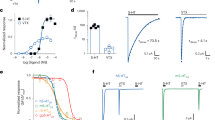Abstract.
One-hundred ninety-one ligands were screened at 5-HT3 receptors in membranes from rat brain and NCB20 cells for their ability to displace the selective, high-affinity 5-HT3 receptor antagonist, [125I]DAIZAC ([125I](S)-5-chloro-3-iodo-2-methoxy-N-(1-azabicyclo[2.2.2]oct-3-yl)benzamide). Thirty-seven compounds having structures related to benzamide, dibenzepine, serotonin, phenylbiguanide, or arylpiperzine were selected for more extensive displacement studies in membranes from rat and mouse brains, from two cultured cell preparations expressing heteromeric mouse-derived 5-HT3 receptor proteins (NCB20 and NG108-15 cell lines), and from recombinant Sf9 cells expressing homomeric 5-HT3A receptors. [125I]DAIZAC bound specifically to a single site in each of the five tissue preparations with high affinity (K D 0.12–0.19 nM). The densities of [125I]DAIZAC-labeled 5-HT3 receptors were 7.4–7.5 fmol/mg protein in membranes from murine brain, and 38, 99, and 1588 fmol/mg protein in membranes from cultured NCB20, NG108-15, and recombinant Sf9 cells, respectively. The affinity of substituted benzamides (n=10) was similar in all five tissue preparations. The affinity of dibenzepines (n=17) was significantly higher in membranes from cultured cells as compared to membranes from rat and mouse brain, but similar in the two brain membrane preparations, and in each of the cultured cell membrane preparations. Serotonin-, phenylbiguanide-, and quipazine-analogs (n=10), which typically function as 5-HT (5-hydroxytryptamine) agonists, exhibited significantly higher apparent pK i values in membranes from rat brain and Sf9 recombinant cells than in membranes from the three preparations expressing heteromeric mouse-derived 5-HT3 receptor proteins (F=7.52, P<0.001). These findings confirm that there are both species and cell-type dependent differences in binding to 5-HT3 receptors, and that care must be taken when comparing results between experimental paradigms that utilize different sources of 5-HT3 receptors.
Similar content being viewed by others
Author information
Authors and Affiliations
Additional information
Electronic Publication
Rights and permissions
About this article
Cite this article
Zhang, ZJ., Trivedi, B.L., de Paulis, T. et al. Discrimination in 5-HT3 receptor binding in murine brain and cultured cell preparations. Naunyn-Schmied Arch Pharmacol 365, 123–132 (2002). https://doi.org/10.1007/s002100100419
Received:
Accepted:
Issue Date:
DOI: https://doi.org/10.1007/s002100100419




